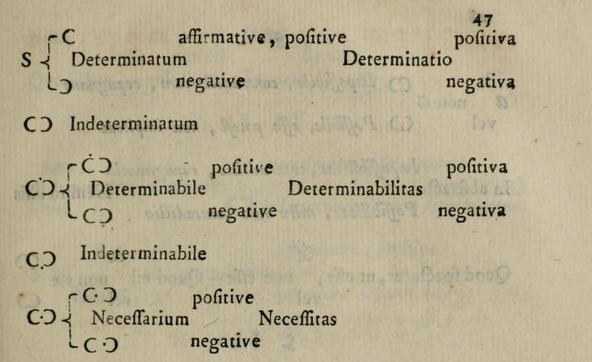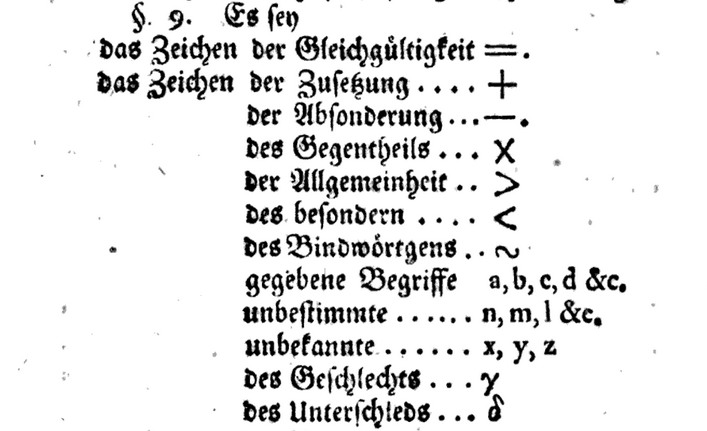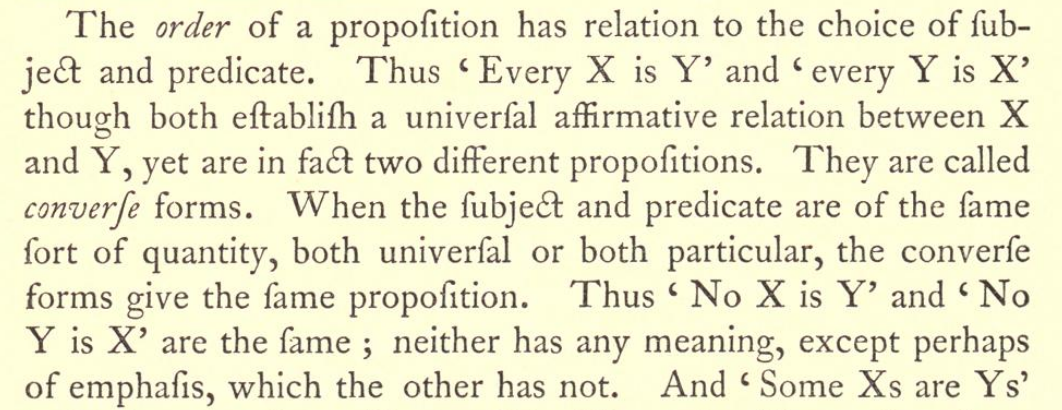- About MAA
- Membership
- MAA Publications
- Periodicals
- Blogs
- MAA Book Series
- MAA Press (an imprint of the AMS)
- MAA Notes
- MAA Reviews
- Mathematical Communication
- Information for Libraries
- Author Resources
- Advertise with MAA
- Meetings
- Competitions
- Programs
- Communities
- MAA Sections
- SIGMAA
- MAA Connect
- Students
- MAA Awards
- Awards Booklets
- Writing Awards
- Teaching Awards
- Service Awards
- Research Awards
- Lecture Awards
- Putnam Competition Individual and Team Winners
- D. E. Shaw Group AMC 8 Awards & Certificates
- Maryam Mirzakhani AMC 10 A Awards & Certificates
- Two Sigma AMC 10 B Awards & Certificates
- Jane Street AMC 12 A Awards & Certificates
- Akamai AMC 12 B Awards & Certificates
- High School Teachers
- News
You are here
Math Origins: The Logical Ideas
Once a mathematics student becomes proficient in the mathematical calculations of the calculus and statistics, there is often a moment when the logical superstructure of mathematics becomes apparent. This may manifest itself through explicit questions, or at least some discomfort about the supposed reliability of mathematical truths. How can we be sure that classic results such as the mean value theorem or the central limit theorem are true? What about the existence of the real numbers themselves? This is the point at which many undergraduate mathematics curricula include a course on mathematical logic and thought.
In the author's own experience, this typically involves a reversal of the order of ideas, from the "order of discovery" so common in problem-solving to the "order of logic" that forms the underlying foundation for mathematical proofs. It becomes clear very quickly that new terms and notations are required to elucidate the mathematical statements and logical relationships at play. Notions such as conjunction and disjunction, implication and equivalence, the universal and the existential, must be carefully separated from one another. Today, the theory of logic and its corresponding notation are viewed as a package: one does not exist independently of the other. However, this was not always so! In this article, we explore some early attempts to organize the theory of logic in systematic ways, along with some of the notational choices that were made. We will find that authors of the 17th and 18th centuries were primarily interested in describing a way of thinking about logic, usually by analogy with pre-existing mathematical or philosophical concepts. In the next article in this series, we will advance the narrative into the 19th and 20th centuries to examine the multitude of notational systems that were proposed for logic.
Some Early Symbols from Johann Rahn
For many students, some logic symbols appear early in their mathematical learning, often as a shortcut or abbreviation to simplify one's thought process. A good example of this is the \(\therefore\) symbol for "therefore," used to conclude a chain of reasoning. An early adopter of this symbol was the Swiss mathematician Johann Rahn. In his 1659 book, Teutsche Algebra (German Algebra) [Rah], Rahn sought to relate the algebraic contributions of Viète, Descartes, and others to a German-language audience. In doing so, he used a number of notational shortcuts to express those ideas. Here's an excerpt.

Figure 1. An algebraic argument in Johann Rahn's Teutsche Algebra (1659) uses \(\therefore\) for "therefore" and * for multiplication. Digitized by Google Books from the copy owned by the Bavarian State Library.
In the second line of this passage, Rahn defined the "three points \(\therefore\)" symbol to carry the same meaning as the Latin ergo. This symbol appears at the conclusion of the argument immediately following: the proportion \(18\sqrt{dd-cc} : (c+d)\sqrt{dd-cc} :: 18 : c+d\) from step 2 is resolved in step 3 as the tautological equation \((18c+18d)\cdot\sqrt{dd-cc} = (18c+18d)\sqrt{dd-cc}\). (Today we would describe this step as using cross-multiplication and distribution to solve a fraction problem.) According to Cajori [Caj, p. 212], this was the first use of \(\therefore\) to mean "therefore." We should also note the column on the right-hand side, in which he referred back to previous steps along with an abbreviated description of the logic for the given step.
Rahn's notational contributions did not end here; 20 pages later he used a few novel symbols to elucidate the logic of a familiar algebraic argument.

Figure 2. Some interesting logic symbols from Johann Rahn's Teutsche Algebra (1659). Digitized by Google Books from the copy owned by the Bavarian State Library.
In this extract, Rahn gave an approach to solve an old problem: given numbers \(D\) and \(F\), find numbers \(a\) and \(b\) whose sum and product equal \(D\) and \(F\), respectively. Rahn has introduced a spiral symbol for exponentiation in line 3, an asterisk * for multiplication in line 4, and what can only be described as a "squiggle" for the square root in line 6. At the end, he has found an expression for \(a-b\) which may then be added to or subtracted from \(a+b = D\), thus replicating the quadratic formula. As used here, these new symbols are a notational shortcut to organize the logic of an argument, not too different from two-column proofs that are used by today's students to organize mathematical proofs.
Leibniz's Pursuit of a Universal Mathematics
In one sense, Rahn merely introduced some symbols to streamline existing arguments, rather than to think systematically about how arguments were constructed. (To be fair to Rahn, this was a valuable innovation in an era when the expense of paper and printing was a nontrivial consideration.) Indeed, it was not for another generation that an attempt was made to systematize logic, by none other than Gottfried Wilhelm Leibniz. For a philosophically-minded scholar as Leibniz, this was part of a more ambitious project: a symbolic and rigorous universal calculus that could be applied to any project in the realm of human inquiry. This was a research program that Leibniz pursued in various forms throughout his long career. As described by Garrett Thomson in his small volume, On Leibniz [Tho, p. 15 ff.], Leibniz had three major goals:
-
Create an alphabet of logic, in which concepts may be encoded in numerical form;
-
Create a dictionary of logic, so that complex concepts may be translated into numerical language;
-
Create a syntax of logic, to govern the ways in which inferences may be made.
The first goal appeared in Leibniz's writing as early as 1666, in the treatise Dissertatio de Arte Combinatoria (Dissertation on the Art of Combinations) [Lei]. Specifically, Leibniz asserted that all propositions (1) can be stated in subject-predicate form, and (2) can be constructed as "complexions" (or, combinations) of simple propositions. In counting the number of ways these complexions can be made from a set of simple propositions, Leibniz was led to the Pascal triangle from combinatorics.
Interestingly, this early treatise on logic was the only such work published by Leibniz during his lifetime. However, Leibniz did devote considerable time to his overall project, ultimately writing over a dozen treatises on various topics in logic. The year 1679 was apparently a fruitful time for Leibniz, as he wrote six papers on the universal calculus that spring. We will explore one of these six, the ambitiously-titled "Regulae ex quibus de bonitate consequentiarum formisque et modis syllogismorum categoricorum judicari potest, per numeros" ("Rules from which a decision can be made, by means of numbers, about the validity of inferences and about the forms and moods of categorical syllogisms"). In his first example, Leibniz deconstructed the proposition "Every wise man is pious" in the following way:
A true universal affirmative proposition, for example
Every wise man is pious
\(+20\;\;\;\;\;\;-33\;\;\;\;\;\;+10\;\;\;\;\;\;-3\)
\(+cdh\;\;\;\;\;\;-ef\;\;\;\;\;\;+cd\;\;\;\;\;\;-e\)
is one in which any symbolic number of the subject (e.g. \(+20\) and \(-33\)) can be divided exactly (i.e. in such a way that no remainder is left) by the symbolic number of the same sign belonging to the predicate (\(+20\) by \(+10\), \(-33\) by \(-3\)). So, if you divide \(+20\) by \(+10\) you get \(2\), with no remainder, and if you divide \(-33\) by \(-3\) you get \(11\), with no remainder. Conversely, when this does not hold the proposition is false. [Par, p. 26]
There are three important observations to make here. First, Leibniz was careful to distinguish between subject and predicate in his statements. Indeed, at the outset of the paper he remarked that "every categorical proposition has a subject, a predicate, a copula; a quality and a quantity." In the above example, the subject "wise man" and predicate "pious" are related via the copula "is", and quality of the proposition is "affirmative." According to Thomson [Tho, p. 20], the subject-predicate relationship was one of Leibniz's fundamental assumptions about logic. Second, Leibniz also distinguished between universal and particular statements. Today, we would refer to universally-quantified and existentially-quantified statements. This increases the level of precision possible when formulating propositions. Lastly, both of these previous facts allowed for a statement to be encoded in terms of integer divisibility. Specifically, the predicate will "divide evenly" into the subject exactly when the proposition is true.
A Wider View: Richeri's Algebrae Philosophicae
Fast forward to 1761, when Ludovico Richeri's Algebrae philosophicae in usum artis inveniendi (An algebra of philosophy, for use in the art of discovery) appeared in print. As the title suggests, Richeri introduced a set of notations to better express logical ideas.



Figure 3. Richeri's set of symbols for representing logical ideas in the Algebrae philosophicae (1761). Digitized by Archive.org from the copy owned by the Natural History Museum Library, London.
As we can see, two circle arcs are used in varying combination to represent logical ideas. For example, the symbol resembling the Greek letter \(\omega\) is used for statements that are deemed possible, while an inverted version of this symbol \(\mho\) is used for contradictory statements. The text continues with an extensive list of symbol pairs that express contrasting concepts in logic: thing and nothing, positive and negative determinations, determinate and indeterminate, possibility and impossibility, mutable and immutable. Most importantly, Richeri's symbols for thing (aliquid) and nothing (nihil) resemble today's symbols for union (\(\cup\)) and intersection (\(\cap\)), respectively. This climax of this short article is a logic diagram that traces the possible outcomes of any object of critical inquiry.

Figure 4. Richeri's tree of logic symbols from the Algebrae philosophicae (1761). Digitized by Archive.org from the copy owned by the Natural History Museum Library, London.
In purely symbolic form, Richeri has given a sort of binary search for philosophical inquiry—indeed, this is the algebraic philosophy that was promised! In words, the tree begins like this:
-
Any statement is either impossible (contradictory, the inverted \(\omega\) in the corner) or possible (noncontradictory, the \(\omega\) at the left end of the tree);
-
If a statement is possible (\(\omega\)), it is either determinate (proven, the lower branch) or indeterminate (unproven, the upper branch);
Following the tree a bit further, we see that any possible, determinate statement must be either affirmative or negative. It's also interesting that Richeri viewed possible, indeterminate statements as being either determinable (provable) or indeterminable (unprovable). All told, Richeri's Algebrae philosophicae is only 16 pages long, with many of those consisting of symbolic representations for various propositions. If you have detected echoes of Leibniz in this paper, you are correct! This is no accident: Richeri specifically cited the Dissertatio de Arte Combinatoria in his work. Specifically, we can see how the subject-predicate form of a proposition has been carried over into the Algebrae philosophicae.
Lambert's Zeichenkunst in der Vernunftlehre
Not long after Richeri's algebra of philosophy was published, Johann Lambert made his own attempt at a symbology of reason in his 1782 work, Sechs Versuche einer Zeichenkunst in der Vernunftlehre (Six attempts at a drawing-art in the theory of reason) [Lam]. Here are Lambert's symbols, from page 5.

Figure 5. Johann Lambert appropriated symbols from algebra and arithmetic to represent logical ideas in Sechs Versuche einer Zeichenkunst in der Vernunftlehre (1782). Digitized by Google Books from the copy owned by the Bavarian State Library.
We see here that Lambert's symbols are more mathematical and less philosophical than Richeri's. In addition to appropriating symbols from mathematics, their meanings are easily recognizable to any modern student of logic; for instance, note the signs for equality (\(=\)), addition (\(+\)), separation (\(-\)), opposition (\(\times\)), universality (\(>\)), and particularity (\(<\)). The idea here seems to be that all analysis of logical ideas should and can be reduced to a form of arithmetic. In this sense, Lambert's approach is much closer to Leibniz, since it relies on an analogy between logic and arithmetic. (Also notice that all three men distinguished between the universal and the particular.)
To see Lambert's arithmetic approach in action, let's consider one of his earlier examples [Lam, p. 11]. Given two statements \(a\) and \(b\), Lambert used \(ab\) to denote that which they had in common, so consequently \(a-ab\) represents those characteristics of \(a\) that are not possessed by \(b\). Interestingly, Lambert's phrase for this is "eigene Merkmale," which could be reasonably translated as "self-characteristics," an echo of the eigen- prefix from an earlier article in this series. By the same token, \(b-ab\) represents those characteristics of \(b\) that are not possessed by \(a\). Thus, the expression \(a+b-ab-ab\) refers to the self-characteristics of \(a\) and \(b\) taken together, today known as a symmetric difference. For this to work, notice that Lambert's \(+\) must be construed not as a union, but as a combination (with possible repetition) of \(a\) and \(b\). At any rate, this concept was given its own symbol, so that \(a\mid b\) represents the aspects of \(a\) that are not shared with \(b\), and vice versa. This results in the logic equation \(a\mid b + b\mid a + ab + ab = a+b\), which states that combining the self-characteristics of \(a\) and \(b\) with two copies of their intersections yields the same result as combining \(a\) and \(b\).
Conclusion... For Now
As we have seen, the general struggle during this period was to develop a way of thinking about logic. Leibniz had a vision—however incomplete—of a universal calculus based on subject-predicate language, Richeri used a philosophy-infused approach to classify statements and provability, and Lambert introduced a notational system to represent logical ideas. The first and last of these relied on an analogy with arithmetic, in that statements and inferences were represented by numbers and operations, respectively. Lambert's method in particular seems like an early Venn diagram in symbolic form, though he thought of his objects as unities possessing several qualities, rather than as sets possessing several elements.
Not surprisingly, this story is hardly over! Some 60 years after Lambert's attempt at systematizing logic, Augustus De Morgan wrote his Formal Logic (subtitled more descriptively as The Calculus of Inference) with much the same goals as his predecessors. In this 1847 publication, De Morgan cleared up at least some of the confusion by formalizing Leibniz's notions of universal and particular through introducing quantification into his calculus. Here is one glimpse of his writing on this subject, in which the word quantity is used to make the distinction between universal and particular.

Figure 6. Augustus De Morgan's explanation of converse forms in mathematical logic, from Formal Logic (1847). Digitized by Archive.org from the copy owned by the University of Toronto Library.
For now, note that some other glimpses from this book can be found on Convergence as one of Frank Swetz's Mathematical Treasures. In the sequel, we will pick up the story with a deeper examination of De Morgan's work in Formal Logic, with a special interest in the notation he chose for quantification. Then we will examine how the struggle of the 19th and 20th centuries was to develop a way of writing about logic. Ultimately, the rise of set theory was to have a profound impact on mathematical logic, and it led to a corresponding change in notations. More on this next time!
References
[Caj] Cajori, Florian. A History of Mathematical Notations, Volume II. Chicago: Open Court Publishing Co., 1928.
[DeM] De Morgan, Augustus. Formal Logic: or, the Calculus of Inference, Necessary and Probable. London: Taylor and Walton, 1847.
[Lam] Lambert, Johann. Sechs Versuche einer Zeichenkunst in der Vernunftlehre. Berlin, 1782.
[Lei] Leibniz, Gottfried Wilhelm, Dissertatio de arte combinatoria. Leipzig, 1666. Available in English translation in Philosophical Papers and Letters (Leroy E. Loemker, editor, 2nd edition) from 1969. Two images are provided in Mathematical Treasures.
[Par] Parkinson, G. H. R., ed. Leibniz Logical Papers. Oxford: Clarendon Press, 1966. Contains many English translations of Leibniz's unpublished works.
[Rah] Rahn, Johann. Teutsche Algebra. Zurich: J. J. Bodmer, 1659.
[Ric] Richeri, Ludovico. "Algebrae philosophicae in usum artis inveniendi." Melanges de philosophie et de la mathématique de la société royale de Turin 1 (1760-61), 46-63.
[Tho] Thomson, Garrett. On Leibniz. Stamford, CT: Thomson Learning, 2001.
Erik R. Tou (University of Washington Tacoma) , "Math Origins: The Logical Ideas," Convergence (June 2019), DOI:10.4169/convergence20190601




